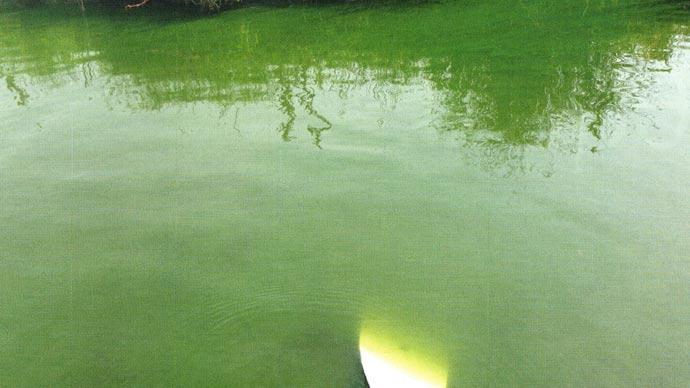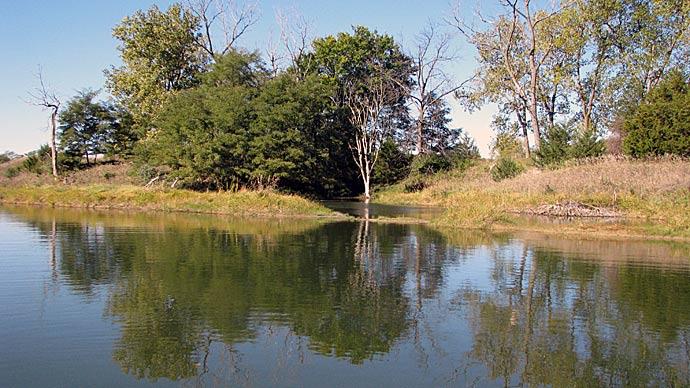
Pond Boss readers likely are interested in their ponds mainly for fishing, but ponds also are important features of the landscape, and they can add to natural beauty. Even ponds infested with aquatic macrophytes— called aquatic weeds by many pond owners— can be rather beautiful. While most sportfish ponds do not have infestations of macrophytes, the appearance of their waters may range from aesthetically pleasing to downright ugly. Thus, I would like to discuss reasons for differences in the appearance of pond waters—especially the color of pond water.
Water is considered to have two kinds of color: apparent color and true color. Drinking water in a clear glass typically is colorless or clear. However, water absorbs and reflects light, and the color we see is reflected light. Pure water absorbs light more strongly at the red end than at the blue end of the visible light spectrum. Thus, more of the blue light is reflected causing a body of clear water to appear slightly blue. This blue color is true color. Also, if you filter a water sample through a fine filter to remove the suspended particles, the color remaining is considered true color. The apparent color in water results from suspended particles.
True color in water also can result from dissolved substances—particles small enough to pass through the filter. A common source of true color in natural water is dissolved organic matter resulting from vegetative material. These substances consist primarily of tannic or humic acids, which usually impart a weak coffee or tea coloration to water, but sometimes the color is a shade of yellow, orange, red, or even black. The bright orange and red colors occasionally seen result from iron bound by the humic substances. Ponds that receive a high input of leaf fall from surrounding trees, capture runoff from a wooded area, or contain dense infestations of higher aquatic plants typically have humically-stained waters.
Humic substances have a slight toxicity to phytoplankton, and they impede light penetration. Humically-stained waters typically are not highly productive. These waters are acidic more often than not, and treatment with agricultural limestone often causes a large decrease in humic color. Liming raises the pH of humically-stained waters and favors microbial decomposition of the humic compounds, which clears the water of the humic stain.
Ponds with clear water are not particularly popular with pond owners who want to have good fish production. Clear ponds usually are impoverished of nutrients and do not have plankton blooms, and light can penetrate to the bottoms of clear ponds to encourage growth of underwater aquatic plants. Either scenario is not conducive to good fish production. Fishponds are fertilized to promote development of plankton blooms, which favor fish production, shade the bottom, and restrict underwater plant growth.
A good fishpond will have a moderate plankton bloom consisting mainly of planktonic algae, but the bloom also will contain a considerable quantity of microscopic animals. Plankton is the base of the food web that culminates in fish production. Plankton blooms typically impart a greenish hue to water, but the color also may be yellow-green, yellow, red, brown, or black. Blue-green algae (cyanobacteria) are common in fertilized fishponds, and as their name implies, they cause a blue-green color. Blue-green algae have a bad reputation, but they are not usually harmful to your pond unless they increase to high abundance and dominate the plankton bloom. When blue-green algae become overabundant, they often float to the surface causing an unsightly scum. The scum often has an unpleasant earthy-musty odor that may be very strong at times. Fish can absorb this odor, giving them a bad flavor. Some blue-green algae excrete toxic substances into the water that can kill fish. Fortunately, this phenomenon is rather infrequent.
Scums of blue-green algae also cause shallow thermal stratification in ponds, and they are associated with low concentrations of dissolved oxygen at night. Blue-green algae scums often die because of excessive sunlight at the pond surface. When this occurs, water will suddenly turn brown with decaying algae, and low dissolved oxygen concentration may lead to fish kills.
The best way to avoid obnoxious levels of blue-green algae is to not over-fertilize your ponds. Nevertheless, nutrient-rich water in fertilized fishponds is an ideal habitat for blue-green algae. Despite your best effort, these potentially harmful algae may develop dense blooms. Copper-based algicides can be used for algal control, but too much copper sulfate can kill all the algae in a pond or even kill the fish. You probably should rely on a pond management consultant if you feel that you must apply algicides.

In ponds with appreciable alkalinity and hardness, the pH of surface water may rise high enough in the afternoon to cause calcium carbonate to precipitate. Fine calcium carbonate particles remain suspended in the water and appear white—a phenomenon known as whitening, but in the evening, pH will decline and the particles of calcium carbonate will re-dissolve.
This effect usually is harmless to fish.
Another common cause of apparent color in pond water is suspended soil particles. Clay and fine silt particles impart their colors, usually red, yellow, brown, gray, or white. Pond owners usually refer to such ponds as muddy ponds. Suspended soil particles interfere with light penetration and lessen productivity in ponds. They seldom harm fish directly, but when suspended soil particles are at high concentrations, the resulting sedimentation may harm fish eggs and benthic animals. Ponds with chronic turbidity problems do not make good fishponds—the exception would be muddy ponds in which fish are offered pelleted feed.
The best way to prevent turbidity in ponds is to find and eliminate its source. Some ponds may remain turbid after elimination of the turbidity source, and residual turbidity can be removed with coagulants such as gypsum, alum, or organic matter. Turbidity problems also should usually be directed to a pond management expert—especially in the use of alum for flocculating turbidity. Alum can be highly effective, but it also can cause a marked decrease in pH.
Some ponds are persistently muddy or humically-stained, but the color of other sportfish ponds tends to be constantly changing. Phytoplankton blooms change in species composition, and as they do so, the apparent color of pond water changes. Blue-green algae blooms can develop very rapidly, and they may die off in a single day, greatly altering pond color. Ponds may also become turbid with suspended soil particles following heavy rains or particularly windy days. The objective for fishponds should be to avoid excessive turbidity from suspended soil particles, and maintain a moderate phytoplankton bloom through fertilization. However, care should be exercised to avoid excessive fertilization that can lead to dense phytoplankton blooms and blue-green algal scums. Good luck.
Dr. Claude Boyd is a retired professor in the School of Fisheries, Aquaculture and Aquatic Sciences, Auburn University, Auburn, Alabama 36849. His work with water quality is internationally renowned. His most recent book, Handbook for Aquaculture Water Quality, is a must for anyone interested in learning about water chemistry and how it relates to your pond. It's technical, thorough, but easy to read and understand. Buy it at www.pondboss.com in the online store or call and order direct from our office (903)564-6144.
Reprinted with permission from Pond Boss Magazine



